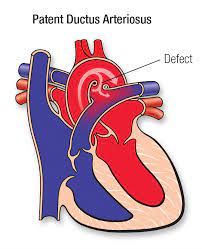Surgical repair for patent ductus arteriosus (PDA) is done to prevent the complication of
Increased pulmonary vascular congestion
decreased workload on the jet side of the heart
pulmonary Infection
Right-to-left shunt of blood
The Correct Answer is A
PDA is a congenital heart defect where a blood vessel called the ductus arteriosus, which is supposed to close shortly after birth, remains open. This allows oxygenated blood from the aorta to flow back into the pulmonary artery, leading to increased pulmonary blood flow and congestion. Over time, this can lead to increased pulmonary vascular congestion and potentially cause complications such as pulmonary hypertension and heart failure.
Surgical repair of PDA, often through a procedure known as ligation or closure of the ductus arteriosus, is performed to stop this abnormal blood flow and prevent the associated complications, particularly the increase in pulmonary vascular congestion.
The other options (B, C, and D) are not the primary complications associated with PDA and surgical repair is not performed primarily to address these issues:
B. Decreased workload on the left side of the heart is not a primary reason for surgical repair of PDA, although it can be a potential benefit of closing the ductus arteriosus.
C. Pulmonary infection is not a direct complication of PDA, but the increased pulmonary blood flow associated with a large PDA can make the lungs more susceptible to respiratory infections.
D. Right-to-left shunt of blood is not a typical complication of PDA. PDA typically involves left-to-right shunting of blood, with oxygenated blood flowing back into the pulmonary circulation, leading to complications related to increased pulmonary blood flow.

Nursing Test Bank
Naxlex Comprehensive Predictor Exams
Related Questions
Correct Answer is ["B","D","F"]
Explanation
When developing a teaching plan to prevent urinary tract infections (UTIs), the following recommendations should be included:
B. Emptying bladder with urination: It's important to encourage regular and complete emptying of the bladder to help flush out bacteria and prevent their buildup.
D. Avoiding bubble baths and tight clothing: Bubble baths and tight clothing can irritate the genital area and increase the risk of UTIs, especially in children. Recommending gentle hygiene practices and loose-fitting clothing can help reduce this risk.
F. Maintaining adequate fluid intake: Staying well-hydrated can help dilute urine and flush out bacteria from the urinary tract, reducing the risk of infection.
The following recommendations are not appropriate or effective for preventing UTIs:
A. Keeping urine alkaline by avoiding acidic beverages: While it's true that some individuals believe that altering urine pH can prevent UTIs, this is not a reliable or evidence-based approach. It's not recommended to manipulate urine pH in an attempt to prevent UTIs.
C. Wearing underwear made of synthetic material such as nylon: The choice of underwear material is not a primary factor in preventing UTIs. However, it's generally recommended to wear breathable cotton underwear as it can help maintain a dry environment in the genital area.
E. Avoiding urination before and after intercourse: On the contrary, urinating before and after sexual intercourse is a recommended practice to help flush out any bacteria that may have entered the urethra during sexual activity.
In summary, teaching about proper bladder emptying, avoiding irritants like bubble baths and tight clothing, and maintaining adequate hydration are key components of preventing UTIs.
Correct Answer is A
Explanation
PDA is a congenital heart defect where a blood vessel called the ductus arteriosus, which is supposed to close shortly after birth, remains open. This allows oxygenated blood from the aorta to flow back into the pulmonary artery, leading to increased pulmonary blood flow and congestion. Over time, this can lead to increased pulmonary vascular congestion and potentially cause complications such as pulmonary hypertension and heart failure.
Surgical repair of PDA, often through a procedure known as ligation or closure of the ductus arteriosus, is performed to stop this abnormal blood flow and prevent the associated complications, particularly the increase in pulmonary vascular congestion.
The other options (B, C, and D) are not the primary complications associated with PDA and surgical repair is not performed primarily to address these issues:
B. Decreased workload on the left side of the heart is not a primary reason for surgical repair of PDA, although it can be a potential benefit of closing the ductus arteriosus.
C. Pulmonary infection is not a direct complication of PDA, but the increased pulmonary blood flow associated with a large PDA can make the lungs more susceptible to respiratory infections.
D. Right-to-left shunt of blood is not a typical complication of PDA. PDA typically involves left-to-right shunting of blood, with oxygenated blood flowing back into the pulmonary circulation, leading to complications related to increased pulmonary blood flow.

Whether you are a student looking to ace your exams or a practicing nurse seeking to enhance your expertise , our nursing education contents will empower you with the confidence and competence to make a difference in the lives of patients and become a respected leader in the healthcare field.
Visit Naxlex, invest in your future and unlock endless possibilities with our unparalleled nursing education contents today
Report Wrong Answer on the Current Question
Do you disagree with the answer? If yes, what is your expected answer? Explain.
Kindly be descriptive with the issue you are facing.
